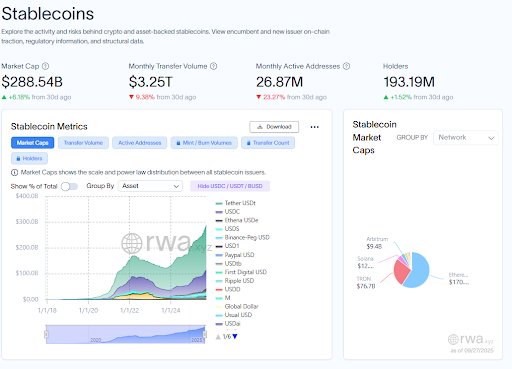Citi projects the stablecoin market to hit $4T by 2030, fueled by regulation, payment adoption, and rising global usage despite slow institutions.
Citi, one of the world’s largest banking and financial services firms, has updated its stablecoin market prediction. The bank now expects the market could grow to $1.9 trillion under its base scenario and as high as $4 trillion in a bull case by 2030.
Drivers Behind the Forecast
Citi analysts identified three major factors that could power the stablecoin market expansion.
First, partial deposit substitution is expected to play a major role. Citi models that about 2.5% of US bank deposits could move to stablecoins by 2030, which would account for 45% of the base-case growth.
Stablecoins have become one of the largest payment rails in the world and settled more than $18 trillion in 2025, surpassing both Visa and Mastercard.@PlasmaFDN is building the infrastructure to make stablecoins the world's largest settlement layer.
— Delphi Digital (@Delphi_Digital) September 24, 2025
Second, the ongoing crypto market expansion contributes another 40% of the predicted growth. The bank expects annual issuance of stablecoins to rise about 20% as new platforms and services integrate them into payment systems.
Finally, about 15% of the predicted growth comes from banknote substitution. This includes an expected 10% shift in overseas US currency holdings and 2.5% of domestic banknotes moving to stablecoins.
Regulatory Clarity Boosts Stablecoin Adoption
The recent passage of the Guiding and Establishing National Innovation for US Stablecoins (GENIUS) Act in the United States has been a major factor behind the revised prediction.
The law creates a clear regulatory framework for stablecoins, which helps both issuers and investors to operate with greater certainty.
Soon after this move, other countries have also started considering their own stablecoin moves. China, which was once sceptical of privately issued tokens, has changed its stance and is exploring yuan-backed stablecoins for cross-border commerce.
In September, AnchorX launched the first offshore yuan-backed stablecoin for commercial use outside the Chinese mainland.
Meanwhile, US Treasury Secretary Scott Bessent said that stablecoins could help expand access to the US dollar, which strengthens its role in international trade.
Institutional Adoption Still Lags
Despite progress in regulation and technology, institutional adoption continues to be limited. Catherine Gu, head of institutional client solutions at Visa, estimated that interest among major companies is at “maybe 0.5 on a scale of 0 to 10.”
Many large firms continue to prefer traditional banking services.
They often benefit from favourable terms and faster settlement times that reduce the appeal of switching to stablecoins.
Citi’s report indicates that tokenised deposits and other bank-issued instruments could overtake stablecoins in transaction volume by 2030.
These bank-backed tokens fit more easily into existing treasury and compliance systems, offering a familiar structure to corporate clients.
Current Market Data
The stablecoin market cap has reached about $292 billion as of late September, and is up from $224 billion at the start of the year.

Stablecoin transactions are now approaching $1 trillion in monthly volume on an adjusted basis, which is nearly double the volume recorded a year ago. This growth shows their increasing role in cross-border transfers, crypto trading and more.
However, there are a few challenges to contend with.
Fragmentation across blockchains, privacy concerns on public ledgers and unresolved accounting treatment issues are limiting stablecoin use in large enterprises. Many corporate treasurers are still hesitating because stablecoins do not yet qualify as cash equivalents under International Accounting Standard 7 (IAS7).
Competition From Bank-Issued Tokens
While stablecoins are showing encouraging signs of growth, Citi believes that bank-issued tokens could eventually dominate in large-scale financial transactions. These instruments include tokenised deposits and deposit tokens, which combine blockchain technology with previously established banking regulations.
Citi projects that such bank-backed digital tokens may process over $100 trillion in annual transaction volume by 2030.
Their integration with existing systems, combined with regulatory certainty, therefore makes them attractive for users seeking efficiency without sacrificing compliance.




